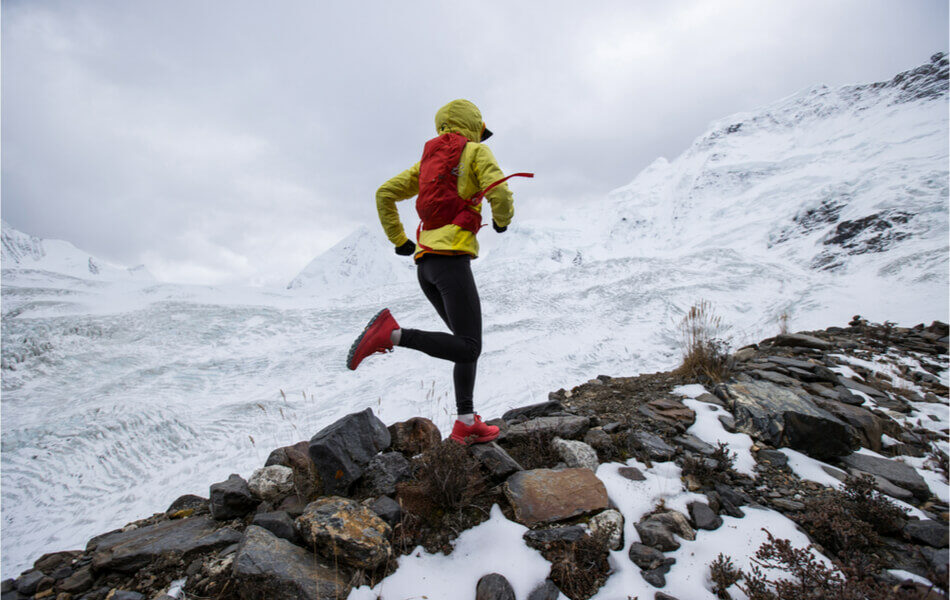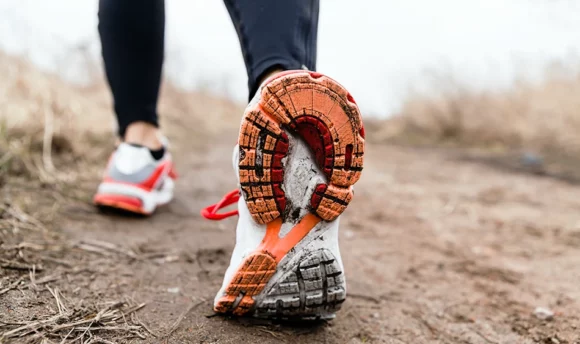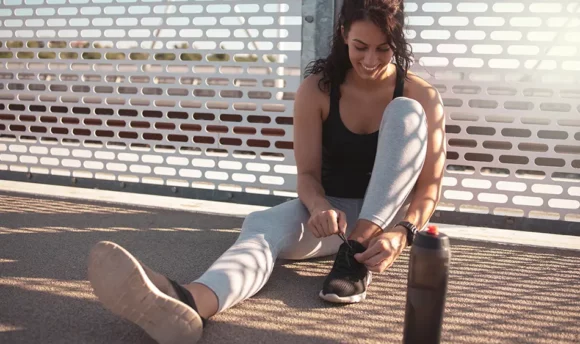Jogging in the Winter: Benefits, Drawbacks, and Tips on How to Prepare
Many runners see winter as a disruption from their workout routine. However, does winter really mean taking a break from running? Today, we look at the facts and see how runners can take advantage of the snow and wind and run outdoors.

We also provide answers to common questions that come with winter running.
Winter is coming, and this is not a drill! You see, the chances are that you will spend less time outdoors due to the cold. Thus, this is a resounding call to those who love exercising in the great outdoors, especially runners.
Getting your daily and weekly dosage of cardiovascular exercises can become increasingly difficult as temperatures begin to plummet. A good number of us would prefer to seek warmth and comfort in our homes, and rightfully so.
The cold temperatures inhibit muscular function – dealing with your extremities, making even something as simple as running quite difficult.
Nonetheless, are you really going to let the cold weather dissuade you from exercising? If the answer is no, then you probably need info on how to go about your routine runs, even as the cold weather gets even colder.
In today’s article, we will be preparing you for your winter jogging. This includes several lifestyle changes, special preparatory needs, and safety tips. So put on your favorite fleece jacket and a comfy pair of shoes, and join us; we want to help you stay fit, so you can start running again.
3 Benefits of Jogging in Winter
Much to the surprise of quite a number of people, many health benefits accompany jogging all through the colder months. Granted, there are times when going on a jog is impractical, such as when the temperature falls below 20ºF, but other than that, you are good to go.
In that respect, we highlight three essential benefits of jogging during the winter months.
#1 Promotes metabolism
Contrary to popular belief, our metabolism does not slow down during winter, unlike bears and other mammals that typically go through hibernation.
When compared to the figures gotten during warmer temperatures, our metabolism sees a major boost during cold temperatures. This proof states, categorically, that your winter workouts will rev up your metabolism.
#2 Builds running endurance
Jogging during winter is also a form of vigorous exercise, as it puts your cardiovascular system through a lot. To combat this, runners must learn a proper breathing technique as it allows them to raise their endurance levels.
The best technique involves breathing in through your nose and out through your mouth. With our airways capable of heating up the air, this technique helps heat up and moisten the air taken in, reducing the risk of respiratory damage.
#3 Burns more calories
Recent studies point out that exposure to cold temperatures creates a weighty increase in the body’s brown fat levels. This, in turn, prompts the body to burn more calories instead of storing them as white fat does.
This disclosure should motivate you to continue your winter jogging routines to hold off gaining an extra pound or two.
3 Drawbacks of Running in Freezing Weather
There are many disadvantages linked with running outdoors during winter. Once again, we have highlighted three crucial problems accompanying jogging while the weather is freezing.
#1 It may affect your lungs
Winter typically means an influx of cold, dry air, which has an acute effect on our respiratory tracts – from your bronchial tubes down to your lungs. This raises your risk of suffering from hard coughs, bronchitis, and severe lung inflammation.
By and large, the resulting effects from cold wind exposure while you go about your winter runs could scale into long-term effects.
#2 Increases risks of injuries
When it comes to the injury factors, slipping and falling are huge factors and regularly happen during winter. Tripping over a huge block of ice can result in broken bones and bruises, which could set you back by weeks.
Then again, winter running has its fair share of running-related injuries, such as torn muscles and tendons. This is primarily because the cold weather slows down the functionality of our bodies. Forcing cold muscles to power through your runs would eventually result in injuries.
#3 Need to prepare running gear in advance
Donning the right gear is a huge factor in your winter run.
Unlike running during warmer periods where you need minimal and less specific running gear, your winter routines demand that you prepare, in advance, an assortment of running gear to participate fully.
The rule of thumb concerning winter clothing is not to wrap yourself up too snugly. Your chosen running gear should leave you feeling a bit chilly when you step outside. The idea behind this is that you want to warm up as you run without sweating too much.
A combination of cold air and sweat will put you at risk of hypothermia, ultimately putting you in a dangerous position.
How to Prepare for a Jog in a Cold Weather
Powering through your winter jog takes a ton of willpower and self-discipline. So as much as we would love to get up and start exercising outdoors, the goal remains to do it as safely as possible.
Nonetheless, if you have zeroed your mind on forgoing the freezing cold and continuing with your routine exercise, we have some tips that will help prepare you for your next jog.
Prepare comfortable and warm clothes
If we have not said this before, we will say it here: you need to wear warm and comfortable clothes, as this is the first and most important step when going on a winter jog.
The best strategy for this is to focus on 3 layers of light, comfortable clothes instead of putting on thick, heavy ones.
Start by wearing a base layer that keeps you warm and your skin always dry. It is important that your base layer (top and bottom layer) can wick moisture from your skin, seeing as moisture leads to more cool-down if left to evaporate on your skin.
Your top base layer can either be long or short-sleeve shirts. Moreover, you could choose between tightly fitted shirts or loose-fitted shirts. As for the bottom base layer, performance tights should be your go-to choice. They are light, breathable, and easy to move in.
The second layer is temperature-dependent (atmospheric temperatures should dictate how thick the cloth is), and it serves the function of heat regulation. Your options should revolve around being able to trap heat without moisture absorption. A Merino wool or fleece jacket is a perfect choice.
Lastly, your outer layer should be of a wind and waterproof material as it protects you from snow, wind, and rain. A jacket is the most practical option there is, and it comes in two categories – softshell and hardshell.
Softshell jackets are light and breathable, except for not being waterproof. On the other hand, hardshell jackets are breathable and waterproof. That makes them the ideal alternative in combating adverse weather conditions like fresh snowfall or heavy rain.
Stretch before a run
A warm-up is an important aspect of any exercise. When it comes to your winter runs, a simple warm-up is very important as it helps raise your core body temperature, increase heart rate, extend motion range, loosen stiff muscles and joints, and open blood vessels.
As such, before you hit the snow-filled curb, make out time to carry out simple, dynamic stretches such as lunges, squats, leg swings, jumping jacks, and arm circles. That way, you feel warmer and well-prepared to get some exercise done.
Choose shoes with traction
Aside from gunning to stay dry, staying on your feet, as well as keeping your feet dry, is a vital part of your winter run. If possible, avoid running on paths covered in snow and ice. There are times when avoiding wet conditions is more or less unfeasible.
That is why investing in the right shoes is an important step. High-quality running shoes should be water and wind-resistant, breathable, and traction-heavy, as this allows you to run safely in all wet conditions.
Nike, Adidas, and New Balance are some of the companies that make high-grade, heavy-duty running shoes. Conversely, you can acquire a slip-on traction device for your running shoe to increase your grip when treading on snowy paths.
We forget it is also imperative that you invest in the right pair of socks. Your winter-themed running socks should be able to wick sweat, as well as provide much-needed warmth and coverage.
Do not forget to stay hydrated
Staying hydrated is another essential facet that goes into your winter jogging preparation. Unlike during hot summer months, when your body demands more fluids, you might not sweat or thirst as much due to the cold.
Nevertheless, exercising and hydration must go in tandem. Drink a lot of water before going on your jog and even after completing your exercise. In the same way, always carry a bottle of water while on your jog.
Do not overdress too much
As much as runners need to wear clothes that can protect them from the cold, they must strive to keep their dressing to the barest minimum. This is because your body temperature will increase as you power through your runs. So, in essence, it will get too hot if you wear too much.
The general rule of thumb is to dress up by 20ºF, seeing as your body heat will make up for the rest. However, if the temperature drops too low and the wind begins to blow, wrapping your body up might just be the best idea. Or you stay safe inside instead of running.
FAQs
Here are answers to some common questions that spring up whenever the discussion encompasses jogging during winter.
Yes, it is safe to run in cold weather, as long as you do not have chronic health conditions and follow the necessary steps concerning exercising and gear selection.
Research by the American College of Sports Medicine delineates -18ºF as too cold for anyone to go jogging.
Running during cold weather is harder primarily because of the strain it places on your musculoskeletal and respiratory systems. But then again, snow, ice, and wind make pathways difficult to advance.
There is no solid evidence concerning the effect of winter jogs on your immune system. However, by staying active, you can help condition your immune system to fight colds, coughs, and infections.
A Word From Our Coach
When it comes to winter running, most runners need to learn a proper breathing technique. You can keep your respiratory tract warm by breathing in through your nose and exhaling through your mouth. Consequently, you can maintain your core body temperature.
Another great practice, aside from covering exposed skin, is covering up your extremities. The idea many runners have that you lose the majority of your heat through your head is simply false. However, your extremities are very sensitive, and improper coverage raises your risk of frostbite.
In that regard, wear a warm cap over your head to protect the nerves on your scalp and face. Special running caps are designed to keep your head and ears warm while draining away sweat. Their selling point is that they do not absorb moisture themselves.
Furthermore, protect your fingers by wearing either gloves or mittens. The gloves you wear must be properly insulated and windproof. Lastly, wear protective socks in tandem with your running shoes to keep your feet warm and dry.
Conclusion
Your winter running escapade will be successful if you stick to the rules: warm up, wear good running shoes, and wear light, protective clothes over those that will make you feel hot.
Moreover, carry your ID, cell phone, and spare cash whenever you go out running. They help cater to unforeseen circumstances such as injury, sudden rain, and hypothermia.
Overall, stay inside if the weather becomes unbearably cold. You must protect your body at all costs.
Sources
- https://www.nih.gov/news-events/nih-research-matters/cool-temperature-alters-human-fat-metabolism
- https://bjsm.bmj.com/content/46/6/397.short
- https://healthreporter.com/what-to-wear-when-running-in-the-cold/#section-2
- https://www.ncbi.nlm.nih.gov/pmc/articles/PMC3290924/
- https://www.cdc.gov/disasters/winter/staysafe/hypothermia.html
- https://www.aipt.edu.au/articles/what-are-dynamic-stretching-exercises
- https://uoflhealth.org/articles/seven-great-benefits-to-cold-weather-workouts/

















































 Select your language:
Select your language: 








